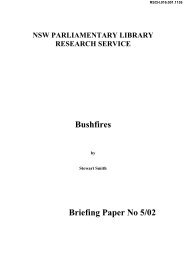Chapter 4 - Warnings - 2009 Victorian Bushfires Royal Commission
Chapter 4 - Warnings - 2009 Victorian Bushfires Royal Commission
Chapter 4 - Warnings - 2009 Victorian Bushfires Royal Commission
Create successful ePaper yourself
Turn your PDF publications into a flip-book with our unique Google optimized e-Paper software.
<strong>2009</strong> <strong>Victorian</strong> <strong>Bushfires</strong> <strong>Royal</strong> <strong>Commission</strong>—Interim Report<br />
4 WARNINGS<br />
4.86<br />
4.87<br />
■■<br />
■■<br />
■■<br />
■■<br />
■■<br />
5 February: the CFA’s Chief Officer and DSE Chief Fire Officer were on ABC statewide radio. They referred<br />
to the ‘unprecedented fire weather’, the fact that, ‘Saturday appears to be worse in terms of weather forecast<br />
terms, than the 16th of February 1983’. In his interview, Mr Rees noted in particular that people might form<br />
the view: ‘given where the situation is, I’m going to make the decision not to be there — that is a very valid<br />
decision’. Mr Ewan Waller, Chief Fire Officer, DSE, noted that people should ‘get mentally prepared as well as<br />
physically prepared for a very, very, very difficult day’. He also stated that fire ‘could be anywhere in Victoria’.<br />
Mr Rees noted the concern that fires in these sort of conditions ‘can pop up really quickly and unless you’re<br />
vigilant, and alert and looking about you may not even get that warning’. 108<br />
6 February: further media releases were issued, for example: Campers urged to stay home during extreme<br />
conditions; 109 Extreme Fire Threat; 110 Extreme Fire Weather Warning; 111 Avoid all unnecessary travel<br />
tomorrow; 112 and High Fire Danger Saturday 7 February. 113<br />
6 February: during the press conference at Ballarat, the Premier said: ‘The worst day ever in the history<br />
of this State’…‘I can’t stress this enough, I mean I know the Chief Fire Officer has been out and he said<br />
it will be as bad as you can get and he is not exaggerating’. 114<br />
6 February: Mr Rees said we would see ‘weather that perhaps we have never had in the State of Victoria<br />
in respect of fire danger’. 115 He also released a podcast which was available online at www.cfa.vic.gov.au<br />
in which he provided a series of statements about the weather, the state of the fuel and the legitimacy of<br />
leaving property. He said ‘we would rather be talking about lost houses than lost lives’. 116<br />
7 February: Mr Esplin was interviewed on ABC Radio at 11:15am, where he said, among other comments:<br />
‘These fires can come and go in the space of an afternoon and do untold damage and that’s what<br />
happened in Ash Wednesday in 1983 — rapid onset, fast moving into built up areas and the human<br />
toll was huge and we don’t want that today’. 117<br />
This narrative indicates that a great deal of information on bushfires and the risk of bushfires was broadcast<br />
in Victoria throughout the 2008–09 bushfire season, and particularly in early February <strong>2009</strong>. This material<br />
was generally of a high quality, attracted significant media attention and achieved high media ‘penetration’. 118<br />
Professor Handmer expressed the view that the use of a person such as the Premier to disseminate messages<br />
is very useful and likely to carry high credibility. 119<br />
Mr Esplin remarked:<br />
I haven’t seen a situation where as many warnings were delivered in that period of time, in such<br />
a period of time. <strong>Warnings</strong> that were stark and clear and unequivocal about the level of risk. 120<br />
4.88<br />
4.89<br />
4.90<br />
4.91<br />
After the fires, the OESC commissioned an independent media analysis of the radio, television and print<br />
coverage for the period 4–7 February. 121 The media analysis confirms that terminology related to fire<br />
predictions and the dire weather forecasts, such as ‘warnings’, ‘heatwave’ and ‘bushfire’ were used<br />
repeatedly in the lead up to 7 February. 122<br />
Professor Handmer stated that the ad hoc high-level ‘warnings’ from people such as the Premier, the Chief<br />
Fire Officers and the Emergency Services <strong>Commission</strong>er were ‘very clear not only about the risk in physical<br />
terms, but also the types of people who might be most vulnerable and the sorts of things that perhaps<br />
people could do’. 123<br />
The message delivered in the days leading up to 7 February were direct in their meaning. The words of the<br />
Premier, the Chief Fire Officers and the Emergency Services <strong>Commission</strong>er showed foresight. Each of them<br />
was honest, forthright and explicit in the information and advice they gave. There is no doubt that each went<br />
to great lengths to disseminate the message that Victoria was facing an extreme fire risk.<br />
These messages no doubt contributed to many <strong>Victorian</strong>s’ preparedness and, possibly, were responsible<br />
for saving the lives of some who heeded those words and left bushfire prone areas prior to 7 February<br />
and/or undertook additional preparations for the bushfire threat.<br />
132
















